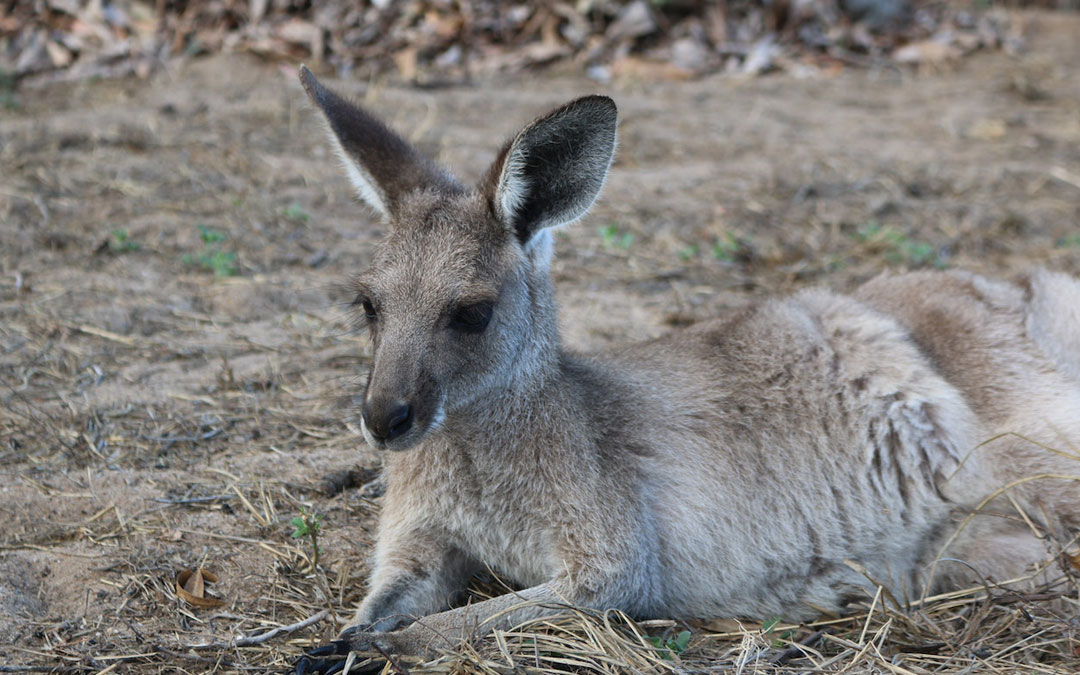Shocking North East Link clearing & what to do if you hit a roo

Most of us have been shocked at the scale of the clearing at the Simpson Barracks on Greensborough Highway as part of North East Link works. Shockingly, the new highway will actually run underground here but they say they need somewhere to park equipment.
The complete bulldozing of all the vegetation, including the probably best remaining stand of more than 50 mature and endangered Studley Park Gum trees (see previous article about them here) was quick, and the results are truly shocking to anyone passing. Imagine the shock the wildlife living there experienced when the bush was wholesale cleared, including the resident mob of Eastern Grey Kangaroos.
Unfortunately, as Friends of Banyule have posted on their Facebook page, within days of the clearing, the kangaroos were in big trouble. A male was badly injured – presumably after being hit by a vehicle – and had to be euthanised. Another male and three females (all with joeys in their pouches) were marooned on the cleared land (where they had been living amongst vegetation only a few days previously). Local residents and Wildlife Victoria (all volunteers!) mobilised and managed to tranquilise and relocate them before they too were hit by vehicles.
Eastern Grey Kangaroos (Macropus giganteus) are an iconic Australian species and are not uncommon around the northeastern suburbs of Melbourne. Unlike solitary Swamp Wallabies, Eastern Grey Kangaroos live in mobs. As marsupials, they give birth to live joeys who climb into the pouch and latch onto a teat. Joeys spend about 9 months in the pouch. Reproduction peaks in summer, meaning many (if not most) females will have live young living in their pouch during the warmer months.
Firstly, I encourage you to voice your concerns to your local state MP about the way North East Link have failed to produce either a humane or environmentally-acceptable way to deliver the new freeway.
Secondly, I encourage you to know what to do if you hit a marsupial (kangaroo, wallaby, koala, wombat, possum etc.) on the road.
- Be aware that marsupials are much more likely to be on roads at dusk and dawn.
- If you do hit something, pull over safely, put on your hazard lights and check everyone in the car is alright.
- If the injured animal is creating a traffic hazard, call Triple Zero (000).
- Even if a marsupial has moved away after being hit, it’s likely injured and will need help. Take note of exactly where you are (instructions on creating GPS co-ordinates on Google Maps).
- Call Wildlife Victoria on 03 8400 7300 (at any time of day or night).
- Be extremely careful if attempting to approach an injured marsupial, they will be terrified and will try to protect themselves.
- If the marsupial is dead, it’s important to check if it’s a female. If it is female (doesn’t have testicles), you need to check its pouch for joey/s. If you don’t have experience or confidence doing this, call Wildlife Victoria for help.
- If there is not a joey in the pouch, check to see if the animal has one elongated teat. If it does it probably means there is probably a joey nearby that will need help.
- If you do find a joey attached to a teat, Wildlife Victoria can talk you through your best option. If there is a joey not attached to a teat, remove it from the pouch and wrap it in a towel, inside your jacket or beanie etc. to keep it warm and secure.
- Immediately take the joey to the closest vet who will treat it free of charge, or call Wildlife Victoria for more advice.
- Once you’ve identified a deceased marsupial as either a male or confirmed there is no need for others to stop and check it, you should move the dead animal off the road and spray paint it with a large visible cross. If you don’t have anything to spray it with, take a photo of it on your phone, take note of your exact location and immediately go to www.wildlifevictoria.org.au to lodge a report so someone else can come and mark it.
For visual instructions, Wildlife Victoria has helpfully made this video.
This process will be confronting for most people. However, it’s part of our collective community responsibility. Thanks to all the Wildlife Victoria volunteers who do this all the time.
Written by Jen Willis.
